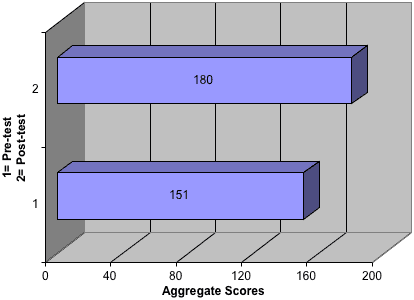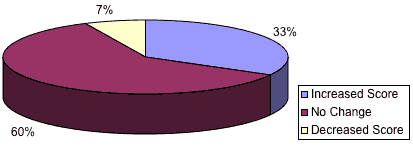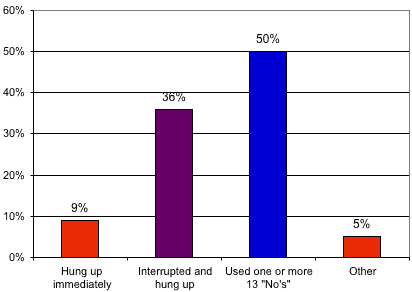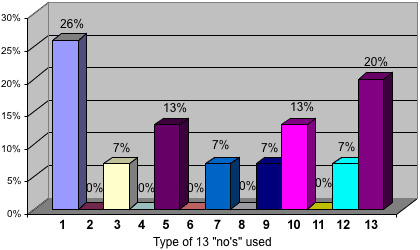June 2004 // Volume 42 // Number 3 // Feature Articles // 3FEA6
Design, Implementation, and Evaluation of an Elder Financial Abuse Program
Abstract
Financial exploitation of elders is the fastest growing crime in America,
with telemarketing schemes being the prime methods used. The authors
developed the Striking Back program, which includes a Leader's Guide,
videotape, practice scenarios, and handouts, to make elders aware of
the problem and provide strategies for dealing with solicitors. Pre/post
knowledge tests were used to determine if learning occurred as a result
of the educational program, and a 6-week follow-up evaluation was conducted
to determine whether elders had adopted key practices that deter telemarketers.
This article presents the program design and implementation strategies
as well as evaluation results.
Introduction
Financial exploitation of the elderly is a growing problem in America. Financial exploitation is a broad term referring to theft or wrongful acquisition of money or objects of value by force or misrepresentation. Elder financial abuse, a more common and specific term, refers to using an elder's money or assets contrary to the elder's wishes, needs, best interest, and/or for the abuser's personal gain (Choi, Kulick, & Mayer, 1999). While all types of elder abuse and neglect are serious problems affecting thousands of vulnerable elders, financial abuse can often deprive the victims of their life savings and assets, and thus, their economic foundation for independence (Choi, Kulick, & Mayer, 1999).
According to Pamela Camille in Getting Older Getting Fleeced, 70% of the wealth in this country is owned by those age 55 and older (1996). In an examination of the net worth of the nation's households, Census data reveals that the median net worth of householders 65 and older is $92,399, as compared to $7,428 for those 35 and under (Census, 2001). These financial realities make the aging population a prime target for con artists.
For example, the North American Securities Administrators Association (NASAA) released a new list of the "Top Ten Investment Scams" and warned the public that many of these scams are targeted directly at older adults (NASAA, 2001). According to NASAA, scammers are fraudulently pitching their investments as low risk and high return to appeal to older Americans looking for a safe haven for their retirement funds (NASAA, 2001).
Financial abuse of elders can also entail misusing "power of attorney" privileges, bogus "home repair" schemes, living trusts misuse, refusing to return borrowed money or property, real estate scams, etc. By far, one of the most significant financial abuses of elders occurs through telemarketing fraud (FBI, 1998).
There are approximately 140,000 telemarketing firms in this country. While there are many legitimate companies that use the telephone for marketing, the Federal Bureau of Investigation (FBI) estimates that there are 14,000 illegal telephone sales operations deceiving consumers in the United States each day (FBI, 1998). A Louis Harris Survey conducted for the National Consumers League (NCL) found that 92% of adults in the United States reported receiving fraudulent telephone offers (NCL, 2000). Americans lose an estimated $40 billion each year due to the fraudulent sales of goods and services over the telephone (FBI, 1998). Also, the U.S. Department of Justice estimates that telemarketing criminals cheat one out of six consumers every year (FBI, 1998).
Elders are purposely targeted in many cases. In an investigation by the FBI, fraudulent telemarketers were directing nearly 80% of their calls at older consumers (FBI, 1998). A comprehensive study by the American Association of Retired Persons (AARP) found that 56% of the names on "mooch lists," what fraudulent telemarketers call their lists of most likely victims, were aged 50 or older (AARP, 2001). Because no firearms are involved in this type of theft, penalties for the small percentage that get caught are minimal (Anders, 1999). Given that the rewards for this type of crime are high (billions of dollars) and the penalties are low (fines, closure of operation), stopping this crime primarily rests with the consumers (Cohen, 1998).
Consumer advocates give four reasons why seniors are at greater risk today than ever before:
- Elders have more assets,
- Elders have more leisure time,
- The schemes are more sophisticated, and
- Elders are more fearful of running out of money (AARP, 2001; FBI 2001; US Trade Commission, 1999).
Consumer advocacy groups acknowledge that educating elderly consumers about telemarketing schemes is an effective way of addressing this issue (Cohen, 1998). Elders can protect themselves by being equipped with knowledge of how to identify fraudulent sales tactics and how to quickly and effectively handle those situations (Cohen, 1998). Finally, elders need to know how to report fraudulent telemarketers and how to achieve assistance if they are constantly being bombarded with calls (Aziz, Bolick, Kleinman, & Shadel, 2000; and US Federal Trade Commission, 1999).
Program Design and Content
A cooperative pilot project between the University of Florida Cooperative Extension and the University of Tennessee Agricultural Extension Service grew out of a regional conference on Elder Financial Abuse held in Montgomery, Alabama in the fall of 2001. At this conference, Extension leaders from seven states outlined strategies for awareness and prevention of elder financial abuse. As a result, in 2002, specialists from Florida and Tennessee took the initiative to design, conduct, and evaluate a pilot educational program called "Striking Back: Elder Financial Abuse Prevention."
The Striking Back educational program was developed to teach participants how to effectively deal with unwanted solicitation. Educational materials used to design the program were prepared by the program developers or adapted from other Extension programs and government agencies.
The Striking Back program content consists of the following:
- Leader's Guide. The leader's guide was developed and organized in a format appropriate for peer educators. The guide included a lesson summary, list of learning objectives, time required to teach the lesson, list of materials and supplies needed, instructions for conducting the lesson, script for introducing the lesson, "extenders" for further discussion on the topics, and copy masters for all visuals and handouts.
- They Can't Hang Up Videotape. This videotape, produced and distributed by the NCL, documents cases of elders who were swindled by telemarketers and debunks common myths about financial fraud victims. The video points out that rather than being isolated and vulnerable, victims are often outgoing, active, and adventurous. For example, it is not widely known that elder men who have been financial risk-takers in their careers may be especially vulnerable.
- Practice Scenarios. Eight scenarios were written based
on actual cases of fraud documented by Tennessee and Florida state
prosecutors. Four of the scenarios dealt with telemarketing schemes,
and four dealt with door-to-door solicitors. In the program, participants
worked in pairs to:
- Develop an appropriate response to each solicitation,
- Identify the scheme perpetrated,
- Determine what sly techniques the caller/visitor might be using to dupe the victim,
- Discuss what harm might come to the person being called/visited,
- Determine what information the perpetrator is gaining about the prospective victim, and
- Discuss how that information might be used to defraud the victim further.
- Ditch the Pitch Publication. This Federal Trade Commission publication focusing on telemarketing fraud gave more detailed information on how to recognize and prevent fraud. It also gave several alternatives for reporting suspect schemes to appropriate regulatory and law enforcement agencies.
- Thirteen Ways to Say No Handout. One of the easiest ways to avoid fraud from telemarketers and door-to-door solicitors is to simply hang up the telephone or close the door. However, the difficulties of persuading older adults to react in this way are well-documented (Cohen, 1998; Eichelbaum, 2001). The current generation of older adults values friendliness, graciousness, and politeness (FBI, 2001). In addition, many have religious beliefs that require honesty. This handout was developed so that participants could select a response they felt comfortable with--one that was firm while still conforming to the values of graciousness and honesty that are often important to elders.
- Fact Sheet. The fact sheet presented basic information about the scope of the problem and some of the barriers to apprehension and prosecution of perpetrators. A list of signs of financial abuse was included so that family/friends might be more likely to investigate suspicious behavior by an elder.
Program Implementation
The Extension Family and Community Sciences agents in six Florida Counties (Hernando, Jackson, Madison, Pinellas, Volusia, and Washington) participated in the pilot project. Agents in these counties were self-selected and agreed to conduct the pilot program within the allocated time frame and provide the requested feedback.
Each county agent announced the program through regular Extension channels such as Family and Community Educators (FCE) Clubs and through collaboration with senior citizen groups and senior citizen centers. A total of 79 elders participated in the program. The county agents taught the program using the instructions in the Leader's Guide and the aforementioned materials provided for the program.
Program Evaluation Methodologies
The mix-method program evaluation consisted of a pre- and post-knowledge test (quantitative) and a follow-up mock telemarketing call (qualitative). The evaluation was approved by the Human Subjects Committee of the University of Florida (UF) to ensure that no harm would be done as a result of the evaluation methodology.
Pre-test/Post-test. A pre/post-test was developed for administration prior to and immediately after the educational program. The test measured five key knowledge areas related to financial fraud and ways to prevent it. Participants (elders) were asked to sign a consent form to participate in the pre/post-test. Ninety-one percent (71) of the elders in the program consented.
At the beginning of the program the county agent asked participants to answer those five questions that measured knowledge of the best ways to handle unwanted telephone calls or door-to-door sales solicitations. The questions were written and placed on an overhead projector in large print. In addition, the agent read each question aloud and asked participants to circle the correct answer on his or her answer sheet. The pre-test was collected prior to the lesson. At the end of the educational program, the agents conducted the post-test (same questions as pre-test) in the same manner as the pre-test.
The follow-up mock telemarketing call was explained, and participants were also asked to sign a consent form agreeing to participate in the follow-up phase of the evaluation. A large majority (84%) of the elders consented, with 66 of the 79 elders signing consent forms for the follow-up evaluation.
Follow up. Six weeks after the program, a randomly selected group of participants (who signed consent forms) were called by a UF researcher and presented with a telemarketing situation to determine if he/she would hang up immediately, as emphasized during training, or at least use one of the thirteen strategies taught. The researcher used a script, approved by the Human Subjects Committee, that was prepared for the mock telemarketing call. The researcher called the elders and presented himself as a telemarketer. A debriefing session occurred with the elders immediately after the "mock telemarketing call" to inform the participant of the project, collect qualitative data, and reinforce teaching points.
Evaluation Results
To assess outcomes, two phases of evaluation were implemented. In the first phase, a pre- and post-test was administered, and in phase two, a random sample of participants were phoned by a mock telemarketer to determine how the participant would respond to a sales pitch.
Pre/Post Knowledge Test
Seventy-nine participants from six Florida Counties (Hernando, Jackson, Madison, Pinellas, Volusia, and Washington) participated in the training, of which 90% (71) agreed to participate in the pilot pre/post evaluation. Only forty-two participants completed both the pre- and post-test because some left the training before the post and a few tests were not turned in or were not usable. Therefore, 42 pre/post-tests were scored and compared.
The aggregate pre-test score was 151, and the aggregate post-test score was 180, representing a 19% increase from pre- to post-test. Thus, there is evidence that learning had taken place during the session (Figure 1a). Individual test scores showed that one-third (14) of the respondents increased their knowledge from pre to post, and 60% (25) made no change in test scores (Figure 1b). Test score data were further analyzed by county. Participants from two counties consistently showed improvement from pre- to post-test. Data from two other counties did not show an improvement on test scores from pre to post-test.
Figure 1a.
Aggregate Change in Knowledge (score) from Pre- to Post-Test

Figure 1b.
Participants' Change in Knowledge from Pre- to Post-Test

Follow-up Evaluation
Phase II of the Striking Back pilot evaluation was a follow-up to determine what participant's learned/retained from the training program. The participants who volunteered to participate received a phone call from a UF researcher who pretended to be a telemarketer. Of the 66 program participants who signed consent forms for the follow-up evaluation, 44 (2/3) were randomly selected to receive the mock call. No messages were left on voicemail. Instead, participants were called on a different day/time in order to reach them. All of the 44 were involved in the follow-up evaluation. The average time for a call was 1.5 minutes.
Half (22) of the participants responded by using one of the 13 ways they were trained to refuse a solicitor (Figure 2). This refusal generally involved hearing the solicitor's offer, then politely using one of the 13 ways of saying "no." Another interesting finding is that 36% (16) interrupted the mock solicitor then hung up (Figure 2). Those participants tended to listen for a while, then interrupt and hang up as soon as money was asked for. Only 9% (4) hung up immediately, even though that is stressed during the training. The "other" category represents 5% (2) who either continued dialog with the mock solicitor or began to consent to donate money (Figure 2).
Figure 2.
Participants' Reaction to Mock Telemarketers

The results of the mock telemarketing call are promising in that elders (50%) are using strategies that have been shown to avoid potential fraud. Teaching elders the 13 strategies for refusing solicitations is even more critical given that many elders will not hang up on people, as evidenced by previous research and the fact that only 9% of the elders in this study hung up immediately even though it was focused on in training. Upon further examination of the data on the 13 strategies, of the 22 participants who used one of the 13 ways to say "no," 26% said "Sorry, I am not interested" (Figure 3). The second most common refusal technique (20%) was "I'm too (ill, busy, annoyed, cranky, distracted) to talk now" (Figure 3).
Interestingly, none of the elders in the follow-up evaluation study selected strategies that dealt with relinquishing their independent decision-making. For example, none of the elders used strategies such as "I have someone who advises me on financial matters" or "Someone else handles my finances." Nor did any of the elders use strategies that would suggest that they did not trust the caller such as "I know you're probably a trust-worthy person, but you know in today's world you just can't discuss these matters with someone you don't know."
The reason that elders did not use the strategies that suggested they needed someone else to help them or that they did not trust the caller perhaps stems from the socialization and values of many elders today. According to a NCL study (2000), when today's elderly population were growing up they were socialized to be friendly, polite, honest, and helpful. Also, numerous surveys conducted by elder advocacy groups consistently show that elders want to maintain their independence.
Additionally, a debriefing session was provided for all 44 follow-up evaluation study participants. The debriefing call was made to each participant after they received the mock telemarketing call. The average time of the debriefing call was 3.5 minutes. During the debriefing call, an Extension representative asked for some qualitative feedback on whether the program helped them handle the call. Overall, the participants indicated that the program was very helpful in giving them the confidence to handle the situation and letting them know that it is okay for them to take control of the situation. For example, some qualitative data/comments from the debriefing call are as follows:
- "I learned that it's okay to be rude."
- "It was a really good program. Liberating!"
- "It helped me a lot. It opened my eyes to what can happen."
- "It particularly helped with the initial response part."
- "I liked the part of the training that talked about not giving your checking account number. I knew about credit cards, but I did not know about how people could use that."
- "The program made me feel like I was in a support group. I liked that and it helped a lot."
- "The program reinforced what I felt was right to do anyway."
- "I easily understood the training, and now I know how to tell them 'I'm not interested.'"
Figure 3.
Type of 13 "Ways to Say No" Used by Study Participants
|
Lessons Learned
One main lesson relates to the structure of program delivery and implementation. Given that each county is different, Extension agents have a lot of autonomy in program delivery. Each county agent participating in the Striking Back program modified the program to fit his/her teaching style and his/her audience. As a result, some agents engaged the audience using the scenarios provided, some used only the videotape, some lectured using the materials, and some used all materials and methods as instructed.
The program developers recommend that structured agent training be administered to all agents who plan to implement the program. Even though a step-by-step leader guide was developed and disseminated followed by a telephone conference, a face-to-face training may help to reinforce the importance of each educational tool being used and can provide agents with confidence in delivering programs to this audience. Also, the program developers suggest providing an incentive to those agents who use the entire packaged program in the manner intended.
Further Study
There are several ways to build on and strengthen this pilot evaluation study. For example, an evaluation design is recommended that uses a comparison or control group and larger sample size of elders. In this way, the program implementers will have stronger evidence that the program is responsible for the knowledge gain and practice adoption/behavior change.
The program developers recommend that further research be conducted to determine which teaching methods are most effective with elders--lecture, role play, videotape then discussion, or a combination of those.
Also, to further provide evidence of program effectiveness, researchers could use an evaluation plan that includes asking family members, financial advisors, and/or caregivers of the elders if they have noticed any changes in the way the elders handle telephone or door-to-door solicitors after the program.
Finally, a research study could examine whether the changes in knowledge and/or behavior would vary based on several key demographic variables such as race, socioeconomic status, geographic location (rural/urban), and living situation (live alone, retirement home living, live with family member).
References
AARP (2001). Telemarketing fraud, Washington, DC. http://www.aarp.org/fraud/home.htm
Anders, K. (1999). Elder fraud: Financial crimes against the elderly. Washington, DC: National Conference of State Legislatures.
Aziz, S. J., Bolick, D. C., Kleinman, M. T. & Shadel, D. P. (2000). The National Telemarketing Victim Call Center: Combating telemarketing fraud in the U.S. Journal of Elder Abuse & Neglect, 12(2): 93-101.
Camille, P. (1996). Getting older Getting fleeced. Anta Barbara, CA: Fithian Press, a division of Daniel and Daniel Publishers.
Census Bureau Report (2001). Net worth of nation's household. US Department of Commerce, Washington, D.C.
Cohen, W.S. (1998). Easy prey: The fleecing of America's senior citizens...and how to stop it. New York, NY: Marlowe and Company.
Choi, N.G., Kulick, D.B., & Mayer, J. (1999). Financial exploitation of elders: Analysis of risk factors based on county adult protective services data. Journal of Elder Abuse & Neglect; 10(3): 39-43.
Eichelbaum, E. (2001). Financial elder abuse. Credit Union Management, 24-s. 2; pg. 38, 2 pgs.
Federal Bureau of Investigation (FBI). (2001). Fraud against the elderly. Congressional Statement to Federal Bureau of Investigation. Available at: http://www.fbi.gov/congress/congress01/lormel0910.htm
Federal Bureau of Investigation (FBI). (1998). Law enforcement bulletin: Telemarketing fraud. Washington, D.C.: US Department of Justice, 13.
National Consumers League (NCL) (2000). Washington, DC. http://www.nclnet.org
North American Securities Administrators Association (2001). Top ten investment scams, Washington, D.C.
US Federal Trade Commission (1999). Facts for consumers: Are you a target of telephone scam, Washington, DC.

